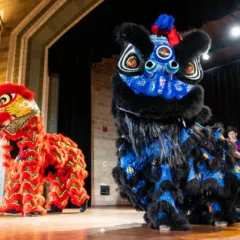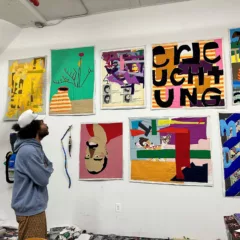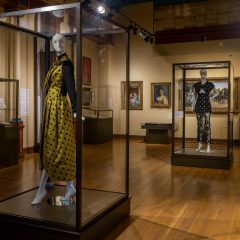(Rachel visits Drexel’s Pearlstein Gallery for a show of recent graduate of the China Central Academy of Fine Arts.–the Artblog editors)
The Start of a Long Journey, on view at Drexel’s Leonard Pearlstein Gallery, is great. The show’s name is brilliant – the concept underscores the burgeoning lives and potential trajectories of 24 young alumni from Beijing’s China Central Academy of Fine Arts (CAFA). With sixty pieces created in the past two years in a range of mediums, styles and artistic intentions, it’s a big diverse show.
The show has wit and subtlety
The project began five years ago in Beijing as an exhibition for graduating students. Known for its extremely low acceptance rate (in 2012 the Academy accepted 1% of applicants) and high caliber of talent, CAFA seems to have produced great creative thinkers.
Sun Mon Il’s painting “Relation No. 1” opens the show with the silhouette of a man walking forward, his pinstripe suit subsuming his body. While the artist’s intention is not stated, critiques of conformity and capitalism are clearly implied. The work’s simple commentary sets the tone for an exhibit full of wit, subtlety and captivation.
Open and evocative narrative works
Some of the show’s highlights include Kim Hyo Sook’s “Empty No. 4,” which will have you circling back to look at it again and again. The sculpture’s immediate impression signals aging and decay, with masterful workmanship to create a wrinkled, flaky surface texture. The figure peers through a white frame, the splintered wood adding another layer of textural feeling. Despite the figure’s rounded back and sunken eyelids, it stands erect with eyebrows lifted, determined and intrigued. From one perspective its face could read worry, remorse or even fear; from another delight, curiosity or captivation. No matter the artist’s intention, narratives surround the artwork.
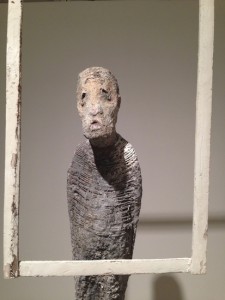
Meng Songlin’s inventive animation “Dinner in a window” exposes Photoshop’s ability to not only produce imagery, but to become art in and of itself. Viewers see food prepared and cooked through a choreographed order of mouse clicks, with Photoshop’s visibility button – the one with the eye that hides and reveals elements on your screen – becoming the artist’s most powerful tool. Not only is the detailed process impressive, but the composed visuals are also fantastically witty, such as vegetables steaming in a pot or bread being portioned as a timer ticks away. And while it could have remained simply charming, the animation’s subject matter and execution conjure up more serious topics such as poverty, the environment and food culture, with viewers contemplating the implications of what it means to cook such an elaborate dinner through photo-editing software.
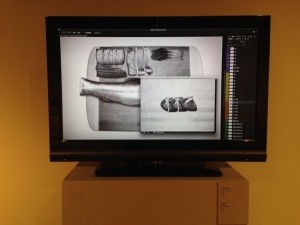
Worm by Wu Mengshi will be the piece that you can’t stop thinking about, unsure whether to chuckle or cringe. In one sense the black lint twitching about on the white clothed form is rather disgusting, yet I guarantee that you won’t be able to turn away. Nevertheless, the kinetic movement and subtle sound has a humor to it that is hard to come by.
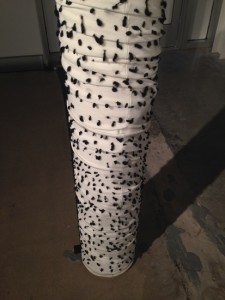
Zhang Yifan’s “Elephant Series” seem to be the pieces that are most responsive to contemporary Chinese life. The combination of digital printmaking, acrylic and laser cutting produces four medium-scale prints that reference construction, technology, urbanism and an overall sense of claustrophobia. The pop of color throughout the series is fantastic and the cultural references are spot on. This is certainly an artist to watch.
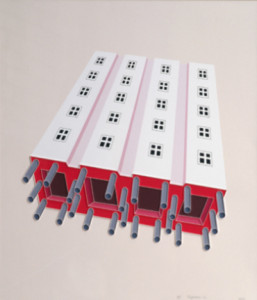
Environmental theme
Wu Wei’s “Adding and Subtracting Series” reminds us that books come from trees, while simultaneously conjuring up notions of intellectual decay. The artist stacks books and then cuts away at their pages in such a way that a rough, bark-like texture is produced. The texture created through mere cutting is remarkable from every angle and distance – and one should make sure to take the time to look. Poetic on numerous levels, its symbolism, and perhaps activism, for education and the environment crosses over into nearly every culture. It is also exquisitely beautiful.
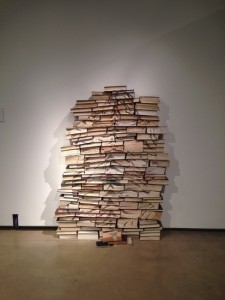
Other notable works include Li Jun’s “Looking to the Right Series” and Zheng Min’s “Birds.” Ye Qiuyang’s “The Landscape in Mist” celebrates the pencil, with twelve immersive variations of Fibonacci Mountain. All three artists – and many more in the exhibition – prove the persuasiveness of subtlety.
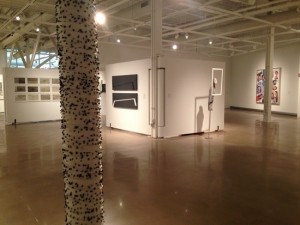
Overall, The Start of a Long Journey is young, fresh and full of talent. Many of the works respond to historical lineages in that remarkably respectful way that is evidence of a great artist. Only occasionally are the pieces unsuccessful – the artists’ intention unclear or execution too contrived. But overall, the show revealed new concepts, a creative use of material manipulation, and a strong showing from artists with definite purpose and aesthetic intuition. You’ll leave it with new cultural references and textures cemented into your visual memory – intrigued, curious, and wanting more.
The Start of a Long Journey is on view through November 22. The Leonard Pearlstein Gallery at Drexel University is free and open to the public Monday – Saturday, 11 a.m. – 5 p.m.


